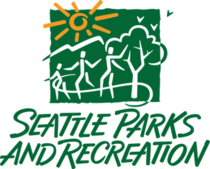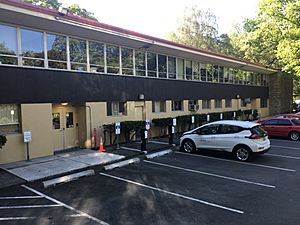Seattle Parks and Recreation facts for kids
 |
|
 Seattle Parks and Recreation headquarters in 2019 |
|
| Department overview | |
|---|---|
| Formed | 1887 |
| Jurisdiction | City of Seattle |
| Headquarters | 100 Dexter Ave N Seattle, Washington, U.S. 47°37′09″N 122°20′31″W / 47.619195°N 122.341928°W |
| Department executives |
|
| Key document |
|
Seattle Parks and Recreation is a government department in Seattle, Washington. Its main job is to take care of the city's many parks, open spaces, and community centers.
This department looks after more than 6,200 acres (about 25 square kilometers) of land. This huge area makes up about 11% of Seattle's total size. About 4,600 acres (18.6 square kilometers) of this land are developed for public use.
In 2007, the department managed 450 parks and 485 buildings. It also took care of 22 miles (35 kilometers) of scenic roads called boulevards. The facilities included 185 sports fields, 122 playgrounds for kids, four golf courses, and 151 outdoor tennis courts. There was also an indoor tennis center, 26 community centers, and 10 swimming pools (two outdoor, eight indoor).
The department also maintains fishing piers, boat ramps, and special places like the Volunteer Park conservatory. Other important sites include the Washington Park Arboretum, the Seattle Aquarium, and Woodland Park Zoo.
The biggest park managed by the department is Discovery Park. The oldest park is Denny Park. A superintendent leads Seattle Parks and Recreation, and a group of volunteers called the Board of Park Commissioners gives advice.
Contents
History of Seattle's Parks
How Seattle's Park System Began
The Seattle Board of Park Commissioners was created in 1887. Its first job was to look after Seattle's very first park, which was simply called Seattle Park. This land was originally a cemetery. It was given to the city in 1884 by a Seattle pioneer named David Denny. Today, the park is named Denny Park in his honor.
In 1892, the city created the job of Park Supervisor. E.O. Schwagerl was the first person to hold this position. At that time, there wasn't any money to buy new parks. However, Schwagerl had a big idea. He imagined parks stretching along the Lake Washington shore. These parks would connect what is now Seward Park all the way to Madison Park. He also pictured a scenic road, or boulevard, along the northern part of this area.
Schwagerl chose Leschi and Madison Parks for a reason. Both were on the lakeshore at the end of trolley lines. Private companies that ran the trolley lines had already developed them into parks. Leschi had a hotel, small houses, and walking paths through the forest. In 1892, John Cort built a large six-story entertainment building there. It was a popular place for early vaudeville shows, which were like variety shows with different acts.
John J. McGilvra's Madison Park had small houses and tent areas. It also had an amusement park. George K. Beede's Madison Park Pavilion could hold 500 people. It had a baseball park and boats for tours on the lake. Later, it even had a track for horse racing.
Both Beede's and Cort's places started with family-friendly fun. But over time, they became more like places where people went to drink beer. Madison Park was updated in 1909 for a big event called the Alaska-Yukon-Pacific Exposition. It was renamed White City Park. Leschi Park became less popular, so the city bought it. Madison Park also became less profitable, especially after Washington state made alcohol illegal in 1916. Eventually, it was also sold to the city's park system. Madrona Park and Alki Beach have similar stories. They were also private entertainment spots that later became city parks.
Growth of the Park System
In the 1890s, before the city bought the commercial parks, George F. Cotterill helped build 25 miles (40 kilometers) of bicycle paths. He was an assistant city engineer and led a group of volunteers. He likely got his ideas from Schwagerl. In 1903, the park commissioners hired the Olmsted Brothers. They were famous landscape architects. Their job was to create a full plan for Seattle's parks. They used Cotterill's bicycle paths as a starting point for a city-wide system of boulevards and parks.
The Olmsted plan had two main goals. One goal was to make sure every home in the city was within half a mile (800 meters) of a park or playground. This made parks available to everyone. The other goal was to connect wealthy neighborhoods with scenic boulevards. These boulevards would avoid the more crowded and less fancy entertainment areas. For example, Lake Washington Boulevard went through the higher lands, skipping the Leschi waterfront. The Olmsted plan became a very important guide for how the city grew.
By 1917, most of Seattle's major parks that we know today already existed. Woodland and Washington Parks were bought in 1900. Since 1903, Woodland Park has been home to the zoo. The zoo used to be a private business at Leschi. Most of Washington Park became a special garden for trees and plants, called an arboretum, in 1941.
In 1904, the city charter was changed. A city charter is like a city's constitution. This new charter gave more power to the Park Board. It meant the Park Board no longer had to report to the Seattle City Council. It gained control over parks, playgrounds, parkways, and boulevards. The board also got its own way to collect money through taxes. Over the next eight years, voters approved $4 million in bonds to buy park lands. Bonds are like loans that the city takes out and promises to pay back.
Seward Park and Ravenna Park were bought before the 1909 Alaska-Yukon-Pacific Exposition. The city used a legal process called eminent domain to buy these lands. Eminent domain allows the government to buy private land for public use, even if the owner doesn't want to sell.
More land along the lakeshore was gained from the state in 1913. This happened with help from Hiram Chittenden of the Port of Seattle. All these building and landscaping projects made the Park Board a big employer. This was especially helpful during times when the economy was slow.
Continued Growth of the Park System
In February 1968, Seattle voters approved a huge $118 million bond issue for the Department of Parks and Recreation. This was part of a program called Forward Thrust. At that time, it was the largest amount of money ever approved for parks and recreation in the United States.
Images for kids


